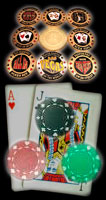Reasons to Bluff
As I said, bluff when you have reason to think your opponent won’t call.
Most of those reasons require you to be able to read your opponent.
Snapping off a Bluff
There are two ways to catch bluffs-reading a player’s body language and behavior and reading cards.
In reading body language or behavior, the general rule is that strong means weak.
That means that players will often intentionally behave in ways to attempt to convey deceptive information. If they are putting have a weak hand.
They are trying to use behavior to intimidate you into folding. Reading cards requires an analysis of the entire play of the hand.
To identify bluffs by reading hands, you need to determine the answer to the question: Is everything he’s done up to now consistent with his holding the hand he’s currently representing? If the answer is no, then suspect a bluff.
Either of these two approaches to catching bluffs requires experience and good poker judgment.
If you’re new to the game, you probably haven’t acquired enough of either of those to be a reliable reader of either people or cards.
There are some situations where many players do have a tendency to bluff. When you run across one of those situations,you should usually suspect a bluff.
One common bluff occurs when an Ace falls. In Holdem, many players will habitually bet as a bluff when an Ace falls on the board as the river card.
Whenever an Ace falls, and an opponent who has been playing passively up to then bets, suspect a bluff. It’s not always a bluff, but it occurs often enough that you should be aware of it.
Often, if you’ll think about the play of the entire round (especially the early betting rounds), you can conclude not only that it’s unlikely that the bettor has an Ace but also that they have a reason to think you don’t have one either.
The main thing to look for when considering whether an opponent is bluffing is consistency of play. An example is a hand I played recently.
In a typical game, with a little loose and mostly weak, predictable opponents, I had Q♦ J♦ on the button. Everyone folded to a late-position player who is usually fairly aggressive.
He limped in. I raised. The small blind called, the limper called the raise. The flop missed me completely that is, a ♠ 9♦ 4♣, but I suspected this flop missed everyone.
The small blind checked and the original limper bet. What did be have?
This was a fairly aggressive player,and he had just limped before the flop. From late position with any Ace this player would have opened with a raise.
Because he hadn’t, I guessed that the best hand he could have was a 9. I called. The small blind folded. The turn brought a second Ace. Now I’m almost certain he doesn’t have an Ace.
Anytime two of a rank are on the board, the statistical chances that another player holds one of that rank are reduced. He checked. Now I don’t even think he has a 9. I bet. He folded.
Apparently his bet on the flop hand been a bluff attempt to win the pot right then.
Just looking the cards, my call on the flop might appear to be a weak call. I had two overcards to second pair. Generally my hand didn’t have a lot going for it.
Why did I call?Because his play hadn’t been consistent with what I knew of his playing habits. With callers in front of him, this player would have raised before the flop with any Ace.
So, even though his bet now might suggest he has an Ace, I’m pretty sure he doesn’t.
It just didn’t fit, and I suspected a bluff, calling just to see what happened next. Whenever your opponent’s past actions aren’t consistent with the hand he appears to be trying to represent now, suspect a bluff. An important concept in that part of your game involves protecting yourself against bluffs.
Look for inconsistencies, and when you find one, exploit it.
It really is valuable to learn your opponent’s habits. In the example I gave, the only habit I needed to have observed was the player’s tendency to be aggressive.
Entering a Public Cardroom / The Play of the Game / The First Betting Round



